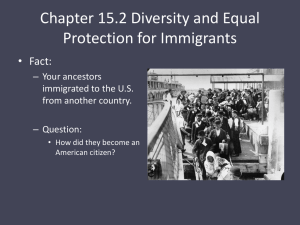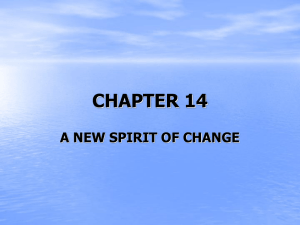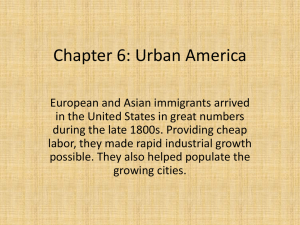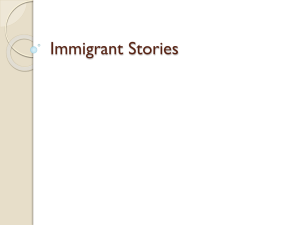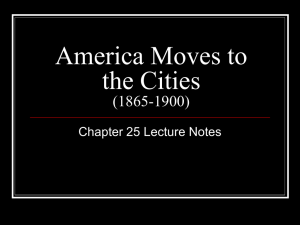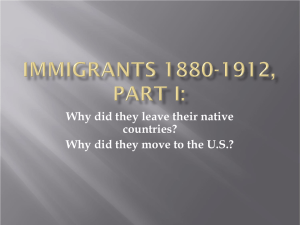Immigration Restriction Efforts, 1875
advertisement
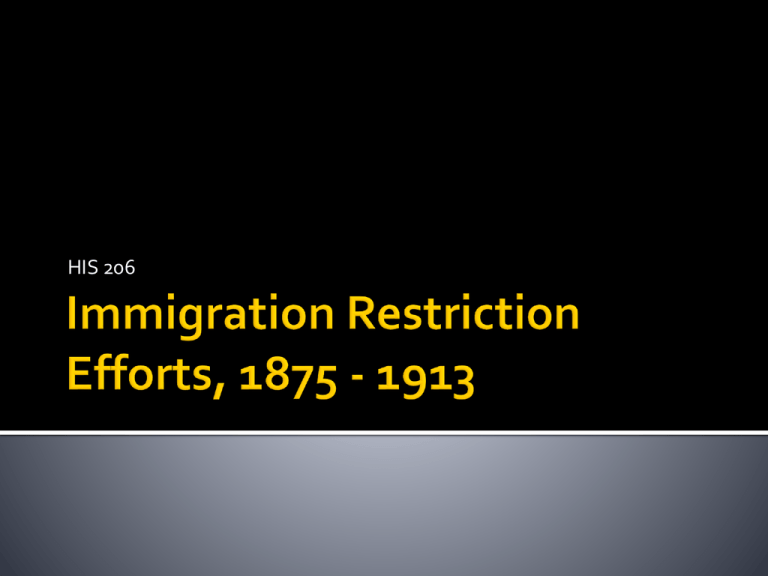
HIS 206 Immigration Act of 1882 followed model of earlier state laws struck down in Henderson v. Mayor of New York (1876) Barred entry to lunatics, idiots & persons likely to become a public charge Imposed 50-cent head tax Secretary of Treasury supervised, but state officials still administed Foran Alien Contract Labor Act (1885) forbade all contracts to prepay or assist immigrants’ passage to U.S. Artists, actors, lecturers, domestic servants & skilled laborers excepted Americans still allowed to help relatives or personal friends Payson Act (1887) barred aliens who hadn’t filed first papers from owning land in the territories House est. Ford Committee (1888-89) to investigate immigration Report said facilities & staff at ports inadequate to inspect immigrants properly Found evidence of assisted immigration for paupers & convicts, & contract labor law easily evaded Warned current immigrants inferior to previous ones & called for exclusion of anarchists & “birds of passage” Ford Committee report = first time Congress distinguished between old & new immigrants “old” immigrants hailed as pioneers who settled as families on the land, assimilated & became citizens “new” immigrants were single men who worked in factories, lived in slums, & were less intelligent & more degenerate Immigration Act of 1891 created federal Bureau of Immigration in Treasury Dept. to oversee inspection & enforcement of laws New federal facilities (e.g. Ellis Island) constructed Persons suffering from loathsome or contagious disease & polygamists excluded Provided for deportation of aliens who entered illegally or became public charges within 1 year of arrival 1891 act gave sole power to review decisions on admission & deportation to Superintendant & Secretary of Treasury Supreme Court ruled in Nishimura Ekiu v. U.S. (1892) that courts couldn’t review inspectors’ findings of fact, only interpretations of laws Court ruled in Fong Yue Ting v. U.S. (1893) that due process didn’t apply to administrative hearings 1893 act required commanding officers of vessels to conduct preliminary investigation of passengers 1894 act raised head tax to $1 to defray increased expense of inspection Edward Bemis & Richmond Mayo Smith called for literacy test to keep out “new” immigrants Henry Cabot Lodge (R-Mass) introduced literacy test bills in Congress, calling for exclusion of inferior races Immigration Restriction League founded in 1894 by Prescott F. Hall & Robert DeCourcy Ward to lobby for literacy test Sen. Lodge Prescott F. Hall Immigrants blamed for evils of urban, industrial America Conservatives claimed they were labor radicals – socialists, anarchists Unions saw them as strikebreakers Social workers decried their unsanitary living conditions Academics claimed they were racially inferior TR warned of danger of “race suicide” Henry F. Bowers founded antiCatholic American Protective Association in 1880s Sons & Daughters of the American Revolution tried to “Americanize” immigrants by teaching them about U.S. history & gov’t The Ram’s Horn, April 25, 1896 Francis Galton coined term to describe scientific study of human genetics with goal of selectively breeding a better human race Influential in U.S. from 1905-1930 Appealed to middle class as explanation for incorrigible poor & delinquent Charles Davenport set up Eugenics Record Office at Cold Spring Harbor, NY in 1910 funded by Carnegie Institute & Harrimans Davenport & assistant Harry Laughlin collected data on how various characteristics were transmitted Worked with Hall & Ward of IRL to pass immigration restriction Difficulty of defining traits Reification – treating complex behaviors as single entities with single causes (e.g., intelligence) Poor survey & statistical methods False quantification Ignoring social & environmental influences William Ripley’s Map of European Races Based On Cephalic Index 33 states passed forced sterilization laws Over 60,000 involuntarily sterilized Upheld by Supreme Court in Buck v. Bell (1927) Sterilization of criminals declared unconstitutional in Skinner v. Oklahoma (1942) Margaret Sanger & other eugenicists also pushed for abortion & birth control to prevent poor from breeding Lodge introduced literacy test bill to Congress in 1896 Based on 25-word passages from U.S. Constitution Limited to English or language of native country Richard Bartholdt tried to sabotage it in House, but still passed Pes. Grover Cleveland vetoed it in 1897, calling it “radical departure” from tradition of asylum House voted to override; Senate did not Richard Bartholdt, R-MO Industrial Commission (1898-1901) recommended: raising head tax to $3 Inspecting cabin passengers & at land borders Excluding & deporting anarchists Extending statute of limitations on deportations to 5 years Penalizing steamship co.s for transporting diseased aliens Pres. Theodore Roosevelt pushed for comprehensive policy to select “good” immigrants & screen out “bad” ones Suggested exclusion of anarchists & immoral persons Recommended literacy test & monetary requirement 1903 Immigration Act reorganized legislation Head tax raised to $2 Inspection at land border crossings Aliens could be deported up to 3 years after arrival Steamship co.s fined for bringing inadmissible aliens & required to transport them back home 1907 Immigration Act raised head tax & monetary requirement Speaker Joseph Cannon fiercely opposed literacy test Conference committee dropped literacy test in exchange for Japanese amendment created U.S. Immigration Commission to study issue U.S. Immigration Commission chaired by Vt. Sen. William P. Dillingham All members except Congressman William Bennett (R-NY) committed to literacy test Issued 42-volume report in 1911 Dillingham Report accepted distinction between “old” & “new” immigrants Economic motivation of “birds of passage” proved U.S. was no longer asylum for oppressed Found existing laws worked well Crime & poverty rates lower than expected Franz Boas’ research contradicted eugenicists Sen. Dillingham Recommendations: Literacy test Better distribution of immigrants Exclusion of “birds of passage” William W. Husband Dillingham submitted literacy test bill in Senate in 1912 Senate bill based on U.S. Constitution John L. Burnett (D-AL) introduced House bill based on words in common usage Secretary of Commerce & Labor Charles Nagel opposed Pres. Taft Became issue in 1912 presidential campaign TR’s Progressive party staked out liberal position on immigration Wilson dogged by earlier negative comments about “new” immigrants in his History of the American People (1902) Taft opposed literacy test as revival of Know-Nothing spirit Charles Nagel Taft vetoed bill in 1913 Conference committee backed House version Taft’s veto message quoted Nagel’s objections Override fell 5 votes short in House





